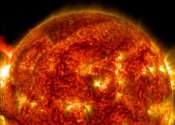First clues to the start of Earth's supercontinent cycle found
Curtin University research has uncovered the first solid clues about the very beginning of the supercontinent cycle of Earth, finding it was kick-started two billion years ago.

Curtin University research has uncovered the first solid clues about the very beginning of the supercontinent cycle of Earth, finding it was kick-started two billion years ago.
Earth Sciences
Mar 24, 2021
0
49

Using information from ESA's Swarm satellite constellation, scientists have made a discovery about how energy generated by electrically-charged particles in the solar wind flows into Earth's atmosphere—surprisingly, more ...
Space Exploration
Jan 12, 2021
0
742

Solar flares—violent explosions on the surface of the sun—can send blasts of radiation hurtling toward Earth. While the planet's magnetic field protects humans on the surface, powerful solar flares can disable satellites, ...
Space Exploration
Jul 31, 2020
135
326

The team of researchers that maintain the World Magnetic Model (WMM) has updated it and released it a year ahead of schedule due to the speed with which the pole is moving. The newly updated model shows the magnetic north ...

Researchers at the Paul Scherrer Institute PSI and ETH Zurich have discovered a special phenomenon of magnetism in the nano range. It enables magnets to be assembled in unusual configurations. This could be used to build ...
Nanophysics
Mar 28, 2019
0
220

For many years, scientists assumed the aurora seen around the north pole was identical to the aurora seen around the south pole. The poles are connected by magnetic field lines and auroral displays are caused by charged particles ...
Space Exploration
Jan 25, 2019
8
326

Scientists working on NASA's Juno mission to Jupiter shared a 3-D infrared movie depicting densely packed cyclones and anticyclones that permeate the planet's polar regions, and the first detailed view of a dynamo, or engine, ...
Space Exploration
Apr 12, 2018
4
441

Combining 26-year old data with supercomputer simulations, a team of scientists at Imperial College London have modelled Neptune's magnetic field in detail for the first time. The researchers find that the furthest planet ...
Space Exploration
Jul 8, 2015
0
80

Europe next week will launch a trio of hi-tech satellites to explore something that may seem utterly mundane: Earth's magnetic field.
Space Exploration
Nov 18, 2013
2
0

The European Space Agency/NASA Solar and Heliospheric Observatory, or SOHO, captured this image of a gigantic coronal hole hovering over the sun's north pole on July 18, 2013, at 9:06 a.m. EDT. Coronal holes are dark, low ...
Space Exploration
Jul 20, 2013
33
3